









1. Design of technological products ....................................................... 7
1 The project method • 2 The design of technological solutions • 3 The technical project • 4 Project disemination • The final challenge
2. Manufacturing of technological products .................................................... 13
1 Technology and products • 2 Industrial Revolutions and production • 3 Material selection criteria • 4 Manufacturing techniques
• The final challenge
3. Analogue electronics 21
1 Passive electronic components • 2 Active electronic components • 3 Tinkercad, a webapp for circuit design • The final challenge
4. Digital electronics .............................. 27
1 Binary logic: states and voltage levels • 2 Basic logic gates • 3 Digital integrated circuits • 4 Simulation of logic circuits with Logisim • The final challenge
5. Programming, simulation and control ....................................................... 35
1 What is Python? • 2 The Python development environment • 3 Operators, variables and data types • 4 Data input and output • 5 Control structures • 6 Python modules • 7 Function declaration • 8 Computer control • The final challenge
6. Control systems and robotics 47
1 Control systems • 2 Arduino • 3 Sensors
• 4 Actuators • 5 Communication fundamentals
• 6 Telecommunications in the Internet of Things
• 7 Devices for programming and control • 8 Big data and artificial intelligence • 9 Shared spaces
• 10 Virtual storage • The final challenge
7. Hydraulics and pneumatics 61
1 Introduction • 2 Physical principles of operation
• 3 Components of pneumatic and hydraulic systems • 4 Symbols • 5 Basic circuits • 6 Use of simulators • 7 Application in industrial systems
• The final challenge
8. Home installations 75
1 Electrical installations • 2 Sanitary water installation • 3 Gas installation • 4 Climate control installations • 5 Communication • 6 Security and home automation systems • 7 Household bills
• 8 Regulation • The final challenge
9. Sustainable technology ................... 87
1 Sustainable development • 2 Bioclimatic architecture • 3 Sustainable transport • 4 Open communities and community service projects • The final challenge


is based on
Technology
Science
Technique which allow the
Technology
Manufacturing of products
Product life cycle
Design and develpment
Use and repair
Recycling and waste
Evolution of technological objects
Industrial standardisation
Quality control
throughout history
The Industrial Revolutions
First industrial revolution
Steam engine
Mechanisation
Mass production
Second industrial revolution
Electricity
Transport
Telecommunications
Third industrial revolution
Oil and automobile
Computer and internet
Globalisation
Fourth industrial revolution
Automation
Artificial intelligence
Data analysis
Are you able to build a vehicle chassis?

SCAN THE CODE TO FIND OUT ABOUT THE CHALLENGE
to achieve it, there must be
Material selection criteria factors that determine strategy
Cost Availability of materials
Physical properties
Durability
Ashby diagrams to view the properties
the methods are for design, analysis and manufacturing
Manufacturing techniques

CAD-CAM-CAE system
for its manufacture
CNC machine tools
Lathe Milling Machine
Digital manufacturing techniques. 3D printing
Inkjet printing
Photopolymerisation
Flux deposition modelling
Polymer extrusion printing
Listening and speaking
Listen and repeat the words to improve your pronunciation.
Reading and writing
Use the branches of the outline to create three sentences about manufacturing of technological products.

Theoretical knowledge about nature is called science. Practical knowledge is called technique. When we combine science and technique to solve a problem, we are talking about technology. Technology is the application of theoretical knowledge and constructive skills to solve problems.
UNDERSTANDING THE WHY OF THINGS
What is the life cycle of your mobile phone?
UNDERSATNDING THE HOW OF THINGS
UNDERSTANDING THE WHY AND HOW OF THINGS +
The life cycle of any product follows several stages:
Design and development
Redesign for new use
Use
Repair
Recycle
Loss of functionality or obsolescence
Fraction of the waste
It starts with design, obtaining raw materials, and making the product. Products become obsolete but can be repaired. Without recycling, redesign, or reuse, a product ends up as rubbish. Recovering parts from discarded products reduces the resources needed for new ones.
Product life cycle analysis (PLC) studies the environmental impact of any raw material, product, or technological solution throughout its useful life.
To determine a product’s environmental impact, the following parameters are evaluated at each stage of its life cycle:
• Water and energy consumption.
• Emissions of greenhouse gases and polluting gases.
• Generation of solid and liquid waste.
• Landscape modification (exclusive to the extraction stage).
Science, technique, technology, life cycle, design, elaboration, use, repair, recycling, redesign, reuse.
1 Choose a product that you use frequently and describe its life cycle phases.
2 Propose a redesign for a product that currently generates a lot of waste (e.g. plastic bags). Explain how your proposal could improve its sustainability through recycling, reuse or redesign.
3 What problem was solved by Johannes Gutenberg’s invention of the movable type printing press? What theoretical and practical knowledge was necessary to develop this technology?
The evolution of technology is not just about creating new things, but also about improving old ones.
This improvement or update of the object defines its life cycle.
• Bringing in new technologies to replace old ones is a key part of technological updates.
• The new product is cheaper to make, which helps product updating. This change also leads to a redesign of the object.
• The new product works better and more efficiently, which means it’s a functional upgrade.
• The new product is more comfortable and safer to use, which makes it a usability update.
• The new product is better for the environment during its production, use, and waste management, which makes it a sustainability update.
An object can undergo different changes:
• Its design can vary, for example, to improve comfort (ergonomics).
• It can incorporate elements that make it safer, more comfortable or functional.
• It can use sustainable energy sources.
Planned obsolescence
Every product has a limited lifespan, and after it expires, it needs to be replaced. However, there’s a business strategy known as planned obsolescence, where products are intentionally designed to have a shorter lifespan.
This practice aims to increase profits through unethical and illegal methods, causing significant environmental harm.
Industrial manufacturing includes many steps that need to work together smoothly. For this to happen correctly, it’s important to set specific rules and standards.
A standard is a technical guideline created and approved by an official organisation. When we apply these guidelines to manufacturing, it’s called standardisation. This process involves creating and improving these guidelines to use in production.
Some industrial standardisation bodies are AENOR, CEN and ISO.
Quality refers to ensuring a product or service meets the required standards and fits its intended use and conditions.
Quality is verified in the different phases of production by controlling and evaluating different product parameters.



4 Find out what the following parts are, according to DIN standards: DIN 318, DIN 911, DIN 7487 E, DIN 127.
5 Find out which ISO standards are responsible for regulating the following areas:
– Quality management systems.
– Environmental management systems.
– Supply chain security management systems.
– Information security management systems.
6 Choose an everyday object, such as a plastic bottle, and redesign it to make it more sustainable. Explain the changes you would make and how they would impact its life cycle.

Human history is full of technical advancements aimed at meeting needs. Mastering fire and making tools were crucial to its evolution. During the Neolithic Revolution, humans learned to farm, raise animals, and discovered metals.
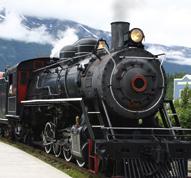

In 1777, James Watts invented the steam engine, which turned coal’s heat, that is its thermal energy, into mechanical energy. It boosted transport (like locomotives and steamships) and mechanised industries, starting mass production, especially in textiles, metalwork, and railways.
Starting from 1880, industrial development sped up and expanded to more countries. Communication improved, propellers were used on ships, and large constructions made transporting goods and people cheaper.
The invention of the dynamo and electric generator switched steam power to electricity. New work methods, like the assembly line and early telecommunications systems, also appeared.
What makes the fourth Industrial Revolution unique?
Steam engine, mechanisation, telecommunications, robotics, automation, big data, digital manufacturing.


After World War II ended in 1945, the third industrial revolution started. It was driven by advancements in nuclear energy, telecommunications, space exploration, computing, robotics, and biotechnology. Oil became the main energy source, and cars became the primary mode of transport. Progress in electronics led to the creation of computers, mobile phones, and the beginning of the Internet. These changes led to globalisation.
Since 2000, Industry 4.0 has emerged, focusing on automation, artificial intelligence, advanced communications, and innovation. This era has seen the development of industrial robots, the rise of social networks, and the creation of data analytics and Big Data.

Factors that determine which materials are chosen for making a product are:
• Cost of acquiring the material.
• Availability of materials.
• Physical, chemical, thermal and mechanical properties.
• Durability.
• Degree of environmental compatibility.
Ashby diagrams
The best material is chosen based on its elasticity, weight, and volume. Ashby diagrams often help with this by showing the material’s elasticity and density.
This diagram reflects a general model for selecting materials.
Define the technological need
Identify material group
Transport of the material to its place of use
Any shipping errors?
Physical examination of the material
Search for an alternative material Select specific material
Return and correction of purchase order
Receipt of the material Issue the purchase order for the material
Choosing materials starts with defining the technological need they must meet. The first step is to identify the type of material, such as metals, wood, or plastics.
In each material group, the material that meets technical, sustainability, availability, or price requirements will be chosen. If it passes these criteria, a purchase order will be made. When it arrives, it will be inspected to ensure it meets specifications before being sent to where it will be used.
What are Ashby diagrams used for?
Ashby diagram.
Material selection, availability, durability, sustainability, Ashby diagrams.
Does it meet the technical requirements?
NO
Does it meet sustainability requirements?
Is it available?
Appropriate cost?
7 Use the Ashby diagram to find the elasticity and density of steel, wood, polyethylene, and glass.
8 Use the materials selection diagram to design and make an efficient thermal insulator for a container that reduces heat transfer.

Today’s industry is highly automated. As a result, factory roles are divided into:
• Designers who create processes for autonomous machines and robots.
• Technicians who maintain and monitor machines and robots to ensure they work correctly.
CAD systems enable the design of 2D plans and 3D models.
CAM systems control programs that interact with machines to manufacture and assemble parts.
The CAD-CAM combination aims to unify design efforts and adapt them for machine interpretation, focusing on boosting productivity from the design phase.
The main advantages of CAD-CAM integration include:
• They optimise the use of various production equipment needed at different stages of manufacturing.
• They increase productivity in machining and help plan manufacturing through plant automation.
Products are designed using computers and CAD (Computer-Aided Design) systems. Their production is carried out by machines that receive these CAD instructions and convert them into the necessary movements and actions to manufacture a part or complete a process. This is known as CAM (ComputerAided Manufacturing).
A third group of tools, called CAE systems, are used to define the characteristics of machines, materials, and system configurations.
How
Manual and mechanical manufacturing techniques
• During the First Industrial Revolution, the first steampowered machine tools were developed, but they couldn’t run continuously.
• In the Second Industrial Revolution, continuous electrical energy allowed machines to run constantly and spin axles faster and more powerfully. Machines like the milling machine and lathe were perfected during this time.
In a milling machine, the cutter spins vertically, while the workpiece stays fixed to the table.
A lathe uses a cutting tool combined with a motor that makes the piece rotate constantly.
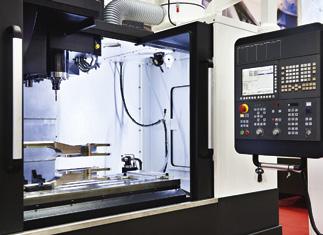

With information technology in industry, machine tools now have control systems to manage the movements of axes and cutting tool, determining their advancement.
Motors are now controlled by a specific program, which is why they are called CNC (Computer Numerical Control) machine tools. In modern CNC machines, the CAD system sends manufacturing instructions to the CNC machine tool.
9 Research the origins of CAD systems and create a timeline of important milestones.
10 List manual and mechanical techniques and machines to make a robot chassis from wood or metal.
Digital manufacturing techniques. 3D printing
3D printing creates solid objects by adding and curing materials. These objects are made from digital models using CAD programs. This technology does not have many limitations in terms of the external shape of the objects, although the interior must have a structure capable of supporting its external walls.
Although some believe that 3D printing began with the creation of the first inkjet printers in 1976, there is a broad consensus that it was in 1983 that this technology really took off with the appearance of stereolithography, a technique invented by Charles Hull.
Most popular 3D printers today have a tray where the printing head deposits material to form objects. After each layer is printed, the head moves up or the tray moves down.
There are various technologies for 3D printing.
printing
These printers work like home inkjet printers but use materials like resins, chocolate, food pastes, or metal mixtures instead of ink. The final product hardens at room temperature. After it’s done, any extra material is removed, often with pressurised water and detergent. Once completed, the final product must be hardened at room temperature. After removal of the workpiece, any remaining material that forms a burr is removed. Depending on the material, pressurised water and detergent are usually used for this operation.
Photopolymerisation
Photopolymerisation is a common technology for quickly making 3D printed prototypes. It uses polymers that react to ultraviolet light. There are various techniques that use liquid or gel resins to create objects. One key technique is stereolithography, where resins are layered and solidified with ultraviolet laser light.
During 3D printing, support structures are often used to prevent the piece from collapsing or deforming. Due to the nature of the materials, finished parts are usually more sensitive to ultraviolet rays, which shortens their lifespan.
Today, some printer models allow different types of resins to be combined simultaneously, more rigid or more flexible. They can also use different colours and mix different materials.
Flux deposition modelling
This technique is very similar to inkjet printing. Perhaps the most notable difference is the use of a laser to achieve greater cohesion of the particles.
Polymer extrusion printing
This technology is popular for good results at affordable prices. Machines use a heated polymer spool that extrudes material through a head onto the tray or bed.
Depending on the polymer used, this bed must be heated so that the part does not deform or adhere properly.
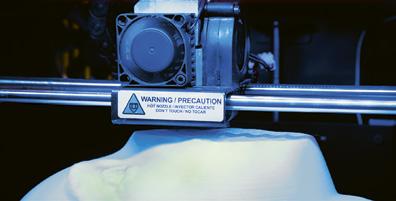
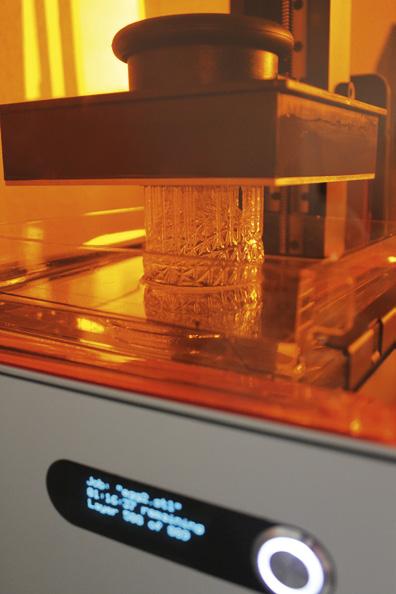
Vocabulary
CAD-CAM-CAE system, inkjet printing, photopolymerisation, polymer extrusion, machining, lathe, milling machine.
11 Create a timeline of 3D printing development.
12 Find and describe other photopolymerisation techniques. Write about them in your notebook in your own words.
13 List the pros and cons of stereolithography as a 3D printing technology.
Let’s continue with the construction of a mobile robot that circulates to the most illuminated spaces in a room. In this step, we will build the chassis we designed in the previous unit.
Chassis parts
In the previous unit we decided that the robot’s chassis will hold the motors, electrical circuit, and sensors. It has three parts: the frame or base, a protective cover, and a front sensor support piece.
Selection of materials
The material you choose for the robot chassis affects the manufacturing methods.
Use the material selection template to choose from these options:
• Option 1: For 3D Printing, print plastic parts using a 3D printer.
Check if you have PLA or ABS, which are suitable materials.
• Option 2: For wood, you could use plywood to make the chassis.. It’s a light, easy-to-work material, and is economical for flat pieces like the front piece and the frame. You can use a hacksaw to cut the plywood.
• Option 3: For metal you could use brass or aluminium. This might be more challenging but can result in a strong and polished finish. Thin aluminium can be cut similarly to wood. However, metal cutting tools are necessary, and the chassis will be significantly heavier.

SCAN THIS CODE TO CONSULT THE GLOSSARY FOR THIS UNIT.
3STEP
Chassis machining
No matter what material you choose, the final step is to create holes and recesses to house the robot components:
• The electrical circuit may move or even collapse while the vehicle is moving. To prevent this, it shall be inserted into the chassis. For this reason, it is necessary to cut out sufficient space for it to fit.
In addition, flanges shall be used to keep it firmly anchored.
• The engines are supported by frames. These are anchored to the chassis using bolts which pass through the chassis.
To ensure that they are completely fixed, it is advisable to include a recess in the chassis to prevent them from moving.
Holes for attaching motors to frame
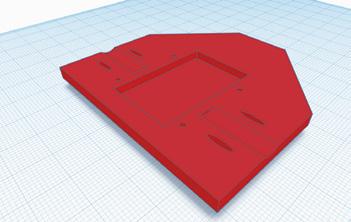
Holes for cable ties, to hold the electrical circuit
Space to accommodate the electrical circuit
Slot to house the engine

SUSTAINABLE TECHNOLOGY
applied in
Bioclimatic architecture
Would you be interested in conducting a study on water management?

SCAN THE CODE TO FIND OUT ABOUT THE CHALLENGE
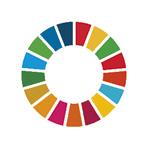
based on improves mobility with alternatives such as
Sustainable transport Open communities

Concepts Healthy habits
Bioclimatic techniques
Design
Sustainable development
to address through
Current issues Technological solutions Improvements

Community services
Environment


Listening and speaking
Listen and repeat the words to improve your pronunciation.
Reading and Writing
Use the branches of the outline to create three sentences about sustainable technology.

The current consumption model, which focuses on increasing product production, generates a significant amount of waste and high energy consumption. This, in turn, depletes natural resources and leads to serious environmental issues.
• An increase in the Earth’s temperature due to the greenhouse effect.
• Acid rain.
• Deforestation and the disappearance of animal and plant species
• Depletion of the ozone layer.
The economic dominance of developed countries results in significant social and economic disparities. Additional factors further exacerbate this imbalance.
The global population continues to increase. In 2000, the world’s population had already surpassed 6 billion, and by February 2023, it had reached 8 billion.
Another significant issue is the accumulation of population in cities. Currently, more than half of the world’s population lives in urban areas.
Population growth and the concentration of people in cities make the mobility and logistics of products and services more challenging. Additionally, the impact on ecosystems and biodiversity in the surrounding rural areas, absorbed by urban expansion, will also be greater.
This issue is being tackled in various ways worldwide. In Spain, the Urban Mobility Strategy has been launched, outlining actions to be taken in five key areas:
• Territory, transport planning and its infrastructure: optimise transportation and incorporate more infrastructure while minimising the impact on ecosystems, landscapes, and biodiversity.
• Fighting climate change and reducing energy dependence: by investing in renewable energies and seeking new non-polluting energy sources, such as long-term nuclear fusion.
• Improving air quality and reducing noise: by minimising emissions from industries and means of transport as much as possible.
• Improving health and safety: by investing in new surveillance and population health control systems.
• Energy demand management: to reduce the cost of transporting energy to consumption points. What measures are being taken to promote sustainable development?
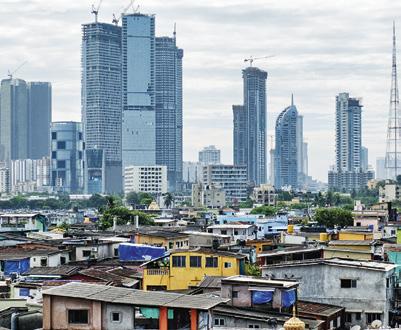
Concentrated overpopulation in cities results from uncontrolled population growth, which leads to inequality and resource scarcity issues.
Source: Business Circle based on Statista, 2021.
1 What is the total number of countries in the world? Which of these have a population of less than 30 million? How many of these countries are experiencing population growth?
Make a list of cities that have more than 20 million inhabitants. In how many of these cities is the population growing?
Industries, transportation, and our daily actions significantly impact the environment. To embrace sustainable development, we need to consider: how to use energy efficiently, support fair trade, improve our cities, and reduce waste.
We don’t need to lower our quality of life to protect the environment. However, certain behaviours can help us achieve this.
In 1987, the UN defined sustainable development as ‘development that meets the needs of the present without compromising the ability of future generations to meet their own needs’.
Sustainable development aims to balance quality of life and environmental respect. It focuses on three key aspects:
• Economic aspect. Economic activities should be both profitable, viable and environmentally friendly.
• Social aspect. Activities should aim to maintain social cohesion and benefit local communities, workers, suppliers, customers, and society in general.
• Ecological aspect. Prevent environmental degradation by reducing non-renewable resource consumption and minimising the impact of waste.
Therefore, our society must prioritise using sustainable technologies, that are more energy efficient, consume fewer raw materials through reuse and recycling of materials, reduce polluting waste, and use renewable energy to minimise environmental impact. For instance, the aeronautical industry has developed new engine designs that reduce fuel consumption by 20%.
Energy saving should also be prioritised in homes by reducing energy consumption and utilising renewable sources. Bioclimatic architecture provides many solutions for this. Additionally, IT and robotics have enabled the automation of processes, like fabric cutting in the textile industry, to minimise waste.
We must reduce waste generation by recovering and reusing materials, either directly or through transformation processes. For example, used tires can be repurposed for paving roads, insulation, or rubber flooring. Used oils can be converted into biofuels, and metals like aluminium from soft drink cans, iron from scrapped vehicles, paper, and glass can be recycled.
2 What is the difference between a linear economy and a circular economy? Provide an example of each.
3 What are the key focus areas of sustainable development?
4 How can we foster interest in sustainable development among young generations?
5 How does technology contribute to sustainable development?
6 What are some examples of waste recycling? List those related to products used in daily life.
Linear economy and circular economy
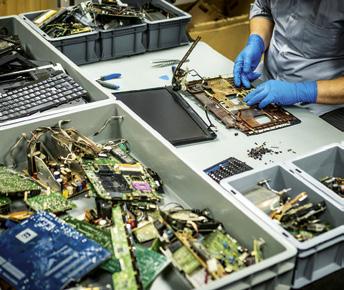
The linear economy seeks to produce at minimum costs, to sell at competitive prices.
The circular economy also aims to produce at the lowest possible cost, but without harming the environment.
Overpopulation, energy consumption, waste, climate change, greenhouse effect, acid rain, deforestation, ozone layer, renewable energies, circular economy, urban mobility, sustainable technologies, bioclimatic architecture, circular economy.

The current growth of cities raises the need to accumulate a larger population in a smaller space. The solution is vertical construction. However, the number of resources required for such constructions makes cities increasingly less sustainable.
Bioclimatic architecture offers a sustainable solution for housing humanity.
Bioclimatic architecture studies, designs, and builds structures and public spaces to maximise natural resources, providing suitable living conditions with minimal environmental impact.
Bioclimatic architecture designs buildings are based on the climatic conditions of each area, utilising natural resources like the Sun, vegetation, rain, and wind. It aims to reduce environmental impact and energy consumption simultaneously.
Bioclimatic architecture includes control and maintenance systems to preserve well-being and habitability. It minimises the effects of weather phenomena by optimising the building’s geographical location and adapting to atmospheric conditions.
To optimise climate resources, the following is necessary:
• Energy saving through passive strategies can be achieved using various design techniques. For example:
– Enhancing the relationship between a building’s exterior surface and its internal volume to measure heat exchange with the outside environment.
– Analysing the proportion of exterior glass surfaces to harness sunlight.
– Implementing bioclimatic architecture techniques, such as building orientation, insulation of walls, doors, and windows, or passive/ natural ventilation and cooling systems.
• Energy efficiency: can be achieved by using low-consumption appliances, equipment, and devices.
• Renewable energy: integrating systems into buildings to generate energy from the Sun (photovoltaic or solar thermal energy), wind (wind energy), waste recovery (biomass), or geothermal energy.
7 Can you give any examples of buildings with a green roof? Look for different examples on the internet and make a list of them.
8 What letter scale is used to identify the energy efficiency of an appliance, and where is it located?
9 List the appliances in your home and identify their energy efficiency levels.
Why is bioclimatic architecture important?
Green roofs and groundcovers provide numerous benefits:
• Control humidity and temperature.
• Provide acoustic insulation.
• Reduce the heat island effect.
• Filter air.
• Lower the risk of flooding by decreasing the volume of water entering sewers.
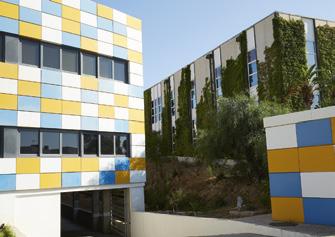
10 What bioclimatic architecture techniques would be suitable for your area?
11 Find examples of buildings in your community that use bioclimatic architecture techniques.
12 List the potential uses for rainwater collected in your daily life.
a) Thermal insulation. Achieved by building thick walls and using suitable materials for windows and doors. In existing buildings, cladding can be applied to the exterior to reduce heat loss.
b) Solar protection. Optimise the use of sunlight according to the seasons. In summer, minimise building heat gain while maximising sunlight exposure for electricity-generating elements.
c) Ventilation inside the house and wind conduction around the building are achieved by arranging walls and partitions to allow natural air circulation. This helps distribute heat evenly or create air currents to cool the house.
d) Climatic use of the ground. In winter, ground temperatures are typically higher than outside air temperatures, while in summer, the opposite occurs. By burying the coldest part of the façade or air pipes in the ground, the resulting currents can help regulate temperature.
e) Proper building orientation. Enhances sunlight usage based on the house’s location and its orientation to the Sun. This technique also affects the installation of solar energy systems.
f) Utilise renewable energy by installing thermal or photovoltaic solar panels, domestic wind turbines, biomass heating systems, or aerothermal energy solutions.
g) Non-polluting natural air conditioning systems. Vapouring cooling systems, which cool the air by passing it through a humidified panel, are among the best known.
h) Use local natural materials, such as adobe, wood, or clay. These materials provide thermal insulation and reduce environmental impact.
i) Use native vegetation in gardens. Opt for deciduous trees that provide shade from solar radiation in summer while allowing light and heat to pass through in winter.
j) Water recycling. Collecting rainwater or treating wastewater for reuse.
Sustainability, passive design, thermal insulation, solar protection, natural ventilation, control systems, renewable energies, solar energy, wind energy, biomass, eco-friendly materials, green roofs, climate utilisation, orientation, water recycling, local materials, native vegetation, ventilation.

As cities expand, private vehicle use has become essential. In recent years, approximately one million vehicles have been registered annually in Spain. However, only 5% of these are hybrid or electric.
In large cities, most space is devoted to mobility and urbanisation, leaving little room for green areas. Sustainable transport has been proposed to mitigate some of the environmental impact of transportation. This requires changing population habits and improving the efficiency of transport systems. These changes must occur at four levels:
• International, as part of the Sustainable Development Goals.
• Continental, with the agreement of all European countries.
• National, through the application of regional and local policies.
• Personal, where each individual is committed to their attitudes.
Some initiatives to improve transportation systems are:
• Replacing fossil fuel traction systems with hybrid and electric systems. Plug-in hybrid vehicles use a combustion engine as a complement to the electric motor.
• Promotion of hydrogen systems for public transport. These systems use electrochemical devices to directly convert chemical energy into electrical energy.
• Incorporating personal mobility vehicles, such as scooters and electric bicycles.
• Integrated traffic control systems to monitor traffic levels and generate emergency messages in case of accidents.
• Traffic control systems to reduce pollution. Managing traffic light networks to promote smoother traffic flow and reduce pollution.
Connected and autonomous vehicles (CAV) are in development, they are programmed to travel routes without human intervention. The Internet of Things is essential for their operation, enabling them to interconnect with other vehicles and objects on the road.
Each person should consider attitudes that are favourable to the environment and health. Some examples include:
• Adapting daily schedules to make journeys on foot.
• Replacing cars with bicycles for short trips.
• Using rail transport for long distances and avoiding air travel when possible.
• Carpooling, driving efficiently, and maintaining vehicles to reduce consumption.
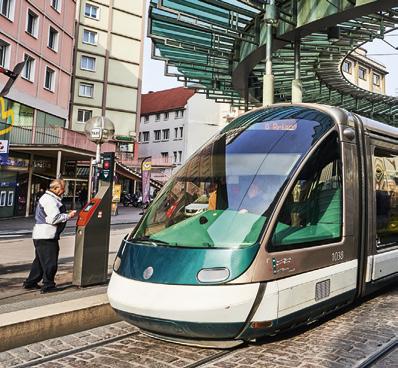
Sustainable transport, Sustainable Development Goals (SDGs), electric vehicles, hydrogen, personal mobility, public transport, railway networks, emission reduction, clean energy, autonomous vehicles, efficient driving.
13 Visit the United Nations page where the Sustainable Development Goals are set out. Make a list of the goals that are directly related to ecotransport.
14 Investigate what measures are being taken in your area to promote sustainable transportation. Make a list of them and add your own proposals.

The Sustainable Development Goals aim to change personal and collective attitudes to improve and sustain living conditions on Earth.
A major issue is that cities, while occupying only 3% of global land, consume 60% of energy and generate three-quarters of carbon emissions. This problem is exacerbated by poor planning, leading to overcrowded areas without basic services or decent housing. This increases inequality and crime.
Therefore, it is crucial to undertake actions such as community projects and fostering open communities.
Open communities try to organise themselves with a focus on social well-being and the care of nature.
One such initiative is ecovillages: intentional communities that encourage the establishment of sustainable settlements where resources such as gardens, sustainable energy generation areas and infrastructure such as communal buildings, paved streets, water supply, electricity and public sanitation systems are shared. For these communities to develop, planning is necessary in several areas:
What are ecovillages? What topics do they cover?
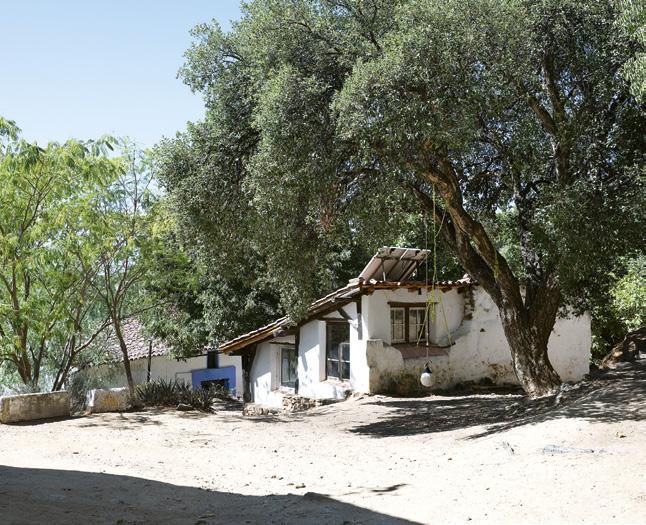
• The social sphere, with acceptance of diversity, education and collective organisation for decision-making.
• The cultural sphere, related to the unitary vision of the world, care for the natural environment and commitment to the collective.
• The ecological sphere, focused on the consumption of local products and awareness of ecological design.
• The economic sphere, fair trade, the strengthening of the local economy and establishing independent systems.
Community service projects allow citizens to contribute their ideas. Many Town Halls select various projects aimed at improving the living conditions of city dwellers.
Technological volunteering aims to reduce the digital divide and social exclusion experienced by many people.
Cyber-volunteering has many areas of application:
• Care for disadvantaged groups.
• Training for people who need to retrain professionally.
• Educational assistance for long-stay hospital patients.
• International collaboration projects in developing countries.
Ecovillages, fair trade, local economy, citizen participation, cyber-volunteering, digital inclusion, technological gap, community networks, social sustainability, collaborative projects, technological volunteering.
15 Visit the Iberian Ecovillage Network website at https://ecoaldeas.org/ Find out if there is an ecovillage in your region and list the activities it promotes.
16 Go to the cyber-volunteers website and search for the network of collaborators in Andalusia.
a) With your current technological knowledge, in what areas do you think you could help?
b) Which group could benefit most from your help?
In this project you will create an infographic to raise awareness about the importance of water management and promote responsible consumption habits.
1 STEP
Find information about the topics you will cover in your infographic. Here are some suggestions:
• The importance of water for living beings. In this section, water can be highlighted as essential for all species on Earth.
• The water cycle. Here you can describe the journey of a drop of water, from its evaporation, to the formation of clouds and its precipitation, forming part of a river and other aquifers that end in the sea.
• The daily use of water, explaining our habits for hydration, cooking, hygiene habits, its use in agricultural and industrial operations, etc.
• What happens when water is scarce? Describe the causes of drought, the areas where it occurs periodically due to the climate, the influence of climate change, overexploitation of water sources, etc.
You can connect each cause with a consequence, such as migratory flows of people and wildlife due to climate change, or episodes of pollution due to lack of treatment of agricultural runoff or industrial wastewater.

SCAN THIS CODE TO CONSULT THE GLOSSARY FOR THIS UNIT.
2 STEP
The infographic may contain solutions that lead to sustainable water management:
• What can be done individually? In this section, include household saving measures, repairing leaks, using efficient appliances, etc.
• What can we do in my community? Describe the importance of establishing water recycling systems, reforestation, proposals for public bodies, etc.
3 STEP
The infographic should highlight the health, economic and environmental benefits of water management.
4 STEP
Check if these criteria are met:
• It combines short texts with images, icons and symbols.
• It includes statistical graphs showing water consumption and expenditure data by region, historical series, consumption per inhabitant according to their economic and social level, etc.
• It offers reliable data obtained from the websites of institutions such as the National Institute of Statistics, the Ministry for Ecological Transition, Greenpeace, WWF and SEO/BirdLife.
1.
4.
5.

Technology
Application of theoretical and practical knowledge to solve problems
Life cycle
Use
Redesign for new use
Repair
Recycling
UNDERSTANDING THE WHY OF THINGS
TECHNIQUE
UNDERSTANDING THE WHY AND HOW OF THINGS + →
UNDERSTANDING THE HOW OF THINGS
1 What is the difference between science and technique?
Products
Design and elaboration Less
Loss of functionality or obsolescence
Evolution
Technological updates
Product updating
Functional upgrades
Usability update
Usability update
2 What phases make up the life cycle of a technological product?
3 Why is quality control important in manufacturing products? Standard Standardisation Specifications for manufacturing processes
Quality control
Ensures that a product or service complies with regulations
External audit
Internal audit


First Industrial Revolution
Steam engine and process mechanisation
Second Industrial Revolution
Fossil fuels, electricity and telecommunications systems
Mass production begins Improved communications and development of assembly lines
Third Industrial Revolution
Technological development, automobile, electronics and internet
Globalisation and sustainability begin
Factors determining selection Cost Availability Properties
Durability
Environmental
Defining the technological need
Fourth Industrial Revolution
Automation, artificial intelligence and industrial robots
Better products and the emergence of data analysis and big data
4 What were the key events of each revolution, and what changes did they bring?
Ashby diagrams
Materials selection in industry
Transport of the material to its place of use
Identifying the material family
Selection of specific material
Finding an alternative material
Any shipping errors?
Physical examination of the material
Return and correction of the purchase order
Does it meet the technical requirements? Is it available? Adequate
Receiving the material Issue the purchase order for the material
5 Describe the process of selecting materials to make a table.
Minimal human intervention in production systems.
Programming of autonomous machines and robots Process design
Maintenance and surveillance
Ensure proper operation of machines
6 What roles do people take on in an automated system?
CAD Systems (Computer Aided Design)
2D plan design and 3D models
CAM Systems (Computer Aided Manufacturing)
Converting designs into manufacturing actions
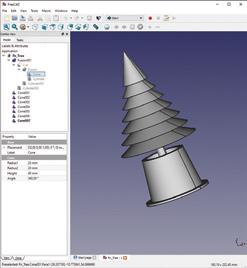
Advantages of CAD-CAM integration
CAE Systems (Computer Aided Engineering)
Analysis of machines, materials and configuration of production systems
Optimises the use of production equipment
Increases the productivity of mechanisation work

7 What are the advantages and disadvantages of integrating CAD-CAM systems?
First Industrial Revolution
Second Industrial Revolution
Present
Steam-powered machine tools (stamping, punching)
Machines with electric motors (milling machines, lathes)
Machines with computer numerical control (CNC) to manage the movements of the translation and rotation axes
8 How have manual manufacturing techniques evolved?
Milling machine
The cutter rotates while the workpiece remains stationary
It creates holes, slots or pieces with various shapes

Additive manufacturing based on digital models
Inkjet printing
Photopolymerisation (light curing)
Flux deposition modeling
Polymer extrusion printing
Similar to home printers. They allow you to combine different types of resins simultaneously
Use of polymers sensitive to ultraviolet light
Similar to inkjet printing. Use of laser for greater particle cohesion
It has a polymer reel that is heated and extruded through a head
The piece rotates and the blade moves Lathe
Ideal for obtaining revolved parts (such as cylinders)
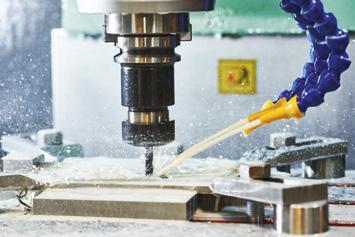

9 What products are manufactured with a milling machine? And a lathe?
10 What are the most common 3D printing techniques?

Current growth based on the production of more products
Depletes resources and generates serious environmental problems
Global warming
Acid rain
Deforestation
Ozone layer depletion
Economic dominance of developed countries
Cities are growing rapidly
Social and economic inequalities
New challenge
Challenges in mobility and environment
Fields of action
Territory, transportation planning, and infrastructure
Combating climate change and reducing energy dependence
Improving air quality and reducing noise
Improving health and safety
Energy demand management
1 What are the main problems we need to solve to achieve sustainable development?
Efficient energy consumption, fair trade, and waste reduction
Sustainable development
Sustainable technologies
Meet our needs without compromising those of future generations
Efficient technologies
Industrial automation
Profitable economy, social cohesion, and environmental conservation
Bioclimatic architecture for energy savings
Waste reduction and reuse
Recycling waste and reusing it in other products
2 What does sustainable development consist of?
Design and construction of buildings using natural resources and with low environmental impact
Objectives of bioclimatic architecture
Key concepts of bioclimatic architecture
Reducing environmental impact
Reducing energy consumption
Energy savings
Energy efficiency
Renewable energy
Seek sustainable solutions
Designs include active control and maintenance
Through passive strategies
Energy-efficient appliances
Considering climatic conditions and optimising resources
Reducing the impact of weather phenomena according to geographic location and seasonality
Form factor of a building
To take advantage of sunlight
Orientation, insulation, ventilation…
Integration of systems capable of generating photovoltaic, thermal, wind, or biomass energy
3 What are the key concepts in bioclimatic architecture?
Building orientation according to the hemisphere to take advantage of sunlight
Thermal insulation to retain heat in winter and avoid it in summer
Solar protection to regulate Sun exposure and shade
Ventilation and air circulation inside and outside
Harnessing ground temperature differences
Utilisation of renewable energies
Water recycling
Using local natural materials for insulation
Native vegetation for temperature control
4 What bioclimatic architecture techniques can be applied to a house that has already been built?
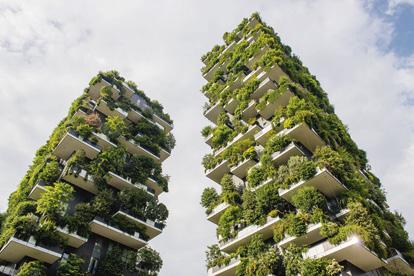
The last 50 years
Increase in dependence on means of transport
An increasing number of gasoline and diesel cars
Problems in Spain
Average age of vehicles: 13 years
Increase in CO2 emissions
Addressing congestion, pollution, and loss of green spaces
Sustainable transportation
Transportation solutions
Limit the use of private vehicles and fossil fuels
Changes in social habits and improvements in transportation efficiency

5 List the problems we need to solve to achieve more sustainable transportation.
Replacement of fossil fuels with hybrid and electric systems
Hydrogen systems for public transportation
PMV (Personal Mobility Vehicles) Scooters and bicycles
Integrated traffic control systems
Awareness and the need for both governmental and individual actions
Changes in social habits
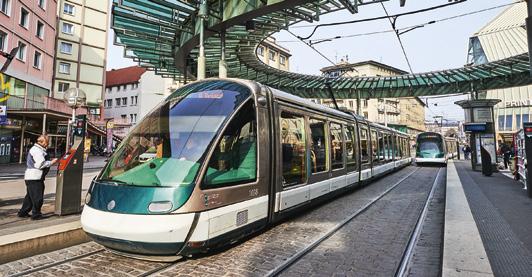
Intelligent traffic light network system
Walking, using bicycles, public transportation and railways, carpooling in private vehicles…
6 What measures can be applied to promote sustainable transportation systems?
United Nations Sustainable Development Goals (SDGs)
Encourage a change in attitude both on a personal and collective level in the global population
Improve the living conditions of all species inhabiting the planet
Achieve sustainability of these improvements over time
SDG 11 Transform cities into more inclusive, safe, resilient, and sustainable environments
Migration from rural areas to cities
Lack of urban planning
Exclusion zones in cities
Lack of access to basic services
Increasing inequality Social problems
To combat these problems
Creation of open communities, such as eco-villages
Community service projects
Cybervolunteering or technological volunteering Collaboration of local, national authorities, and citizens
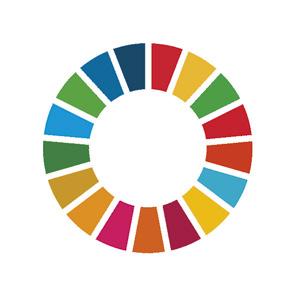
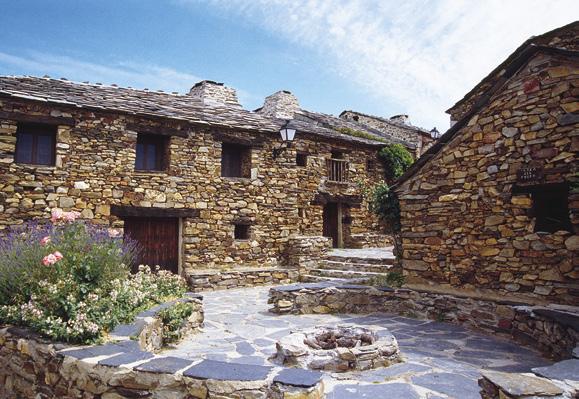
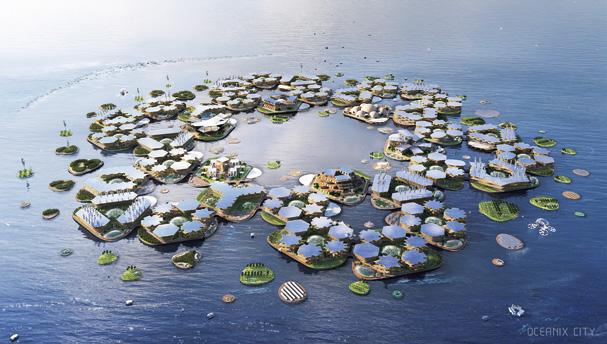
7 What measures help achieve SDG 11 to transform cities into more inclusive, safe, resilient, and sustainable environments?
All rights reserved. No part of this publication may be reproduced, stored in a retrieval system, or transmitted, in any form or by any means, electronic, mechanical, photocopying, recording, or otherwise, without the prior permission of the publishers.